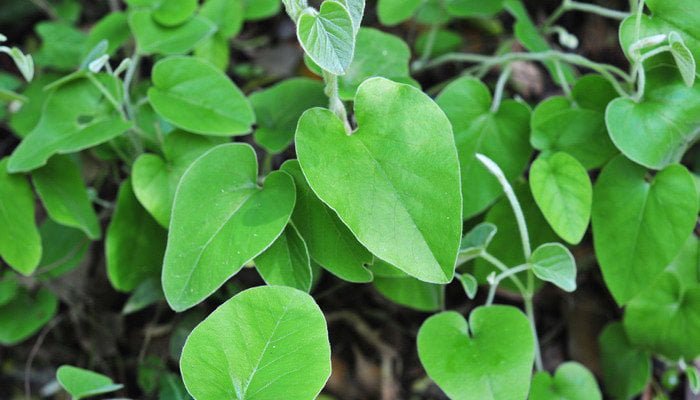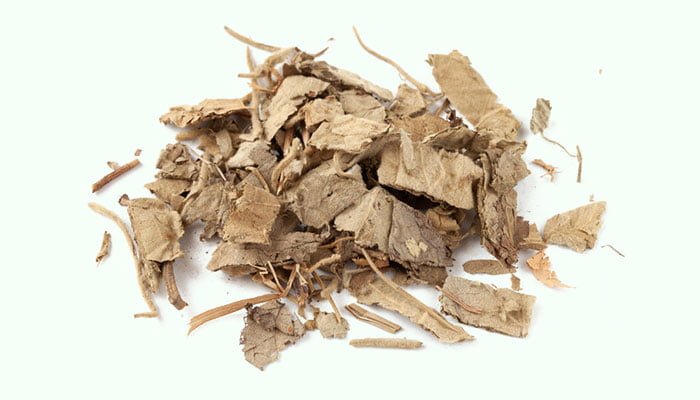What Is Xun Gu Fen
Xun Gu Feng is commonly known as Aristolochia Mollissim, which is a perennial woody vine belonging to the family Aristolochiaceae. It is a relatively practical Chinese herbal medicine, which first appeared in <Zhi Wu Ming Shi Tu Kao> (Illustrated Plant Book) around 1841~1846 AD.
Aristolochia Mollissim is unique to China. They are distributed in Shaanxi, Shanxi, Shandong, Henan, Hubei, Hunan, Guizhou, Jiangxi, Zhejiang, and Jiangsu. They often grow on hillsides, grasses, ditches, and roadsides at an altitude of 100-850 meters. At present, they have not been cultivated by artificial introduction.
In summer and autumn, people gather all the parts of Aristolochia Mollissim, remove impurities, dry them in the sun, cut them into segments, and make them into Chinese herbal medicines.

Xun Gu Feng contains aristoloactone, aristolochic acid A, arostoloterpenate I, β-sitosterol, sesquiterpene lactone, α-pinene, β-pinene, amphene, eudesmin, camphenilone, camphor, borneol, bornyl formate, bornyl acetate, elemene, β-carypohyllene, allantoin, palmitic acid, stearic acid, triacontol, vanillic acid, and some trace elements.
Generally, Xun Gu Feng with brown-yellow rhizomes, gray-green or yellow-green leaves, yellow-white cross-section, and radial texture is preferred.
According to <Yin Pian Xin Shen> (Monograph of decoction pieces), the medicinal nature of Xun Gu Feng is relatively neutral, with a bitter and pungent taste. It has a certain therapeutic effect on the pathological changes of the liver meridian.
In traditional Chinese medicine, it is often used to expel wind and dampness, activate meridians and relieve pain, treat rheumatic arthritis, rheumatoid arthritis, joint pain, numbness of the limbs, bone bi-disease, stomach pain, toothache, testicular swelling and pain, sciatica, trigeminal neuralgia, traumatic injury, traumatic hemorrhage, acute mastitis, purulent infection.
There are about 30 kinds of Chinese medicine prescriptions containing it, such as Shao Lin Zheng Gu Jing, Shang Shi Zhen Tong Gao, and Du Zhong Zhuang Gu Capsules.
Benefits
- Anti-inflammation, inhibiting formaldehyde-induced toe swelling in mice and xylene-induced swelling of mouse auricles.
- Increasing the pain threshold, prolonging the latency of pain response in mice induced by thermal stimulation, and reducing the number of writhing responses in mice induced by acetic acid.
- Lowering the body temperature of fresh yeast-induced fever rats.
- Enhancing the phagocytic ability of macrophages and improving immunity.
- Expelling wind and dampness, treat rheumatic arthralgia, numbness of the limbs, tendon spasm, disadvantageous flexion and extension of joints.
- Activating meridians, alleviating swelling and relieving pain, and treating a traumatic injury.
- It cooperates with pentobarbital sodium to prolong the sleep time of experimental mice.
- Inhibiting the growth of S37 sarcoma and Ehrlich ascites carcinoma in mice.
- Anti-fertility experiments in mice confirmed that aristolochic acid A has the effect of terminating the pregnancy.
Combinations
- It can be used in combination with Wei Ling Xian (Radix Clematidis), Qiang Huo (Rhizoma et Radix Notopterygii), Fang Feng (Radix Saposhnikoviae), Dang Gui (Radix Angelicae Sinensis), etc. to treat rheumatic arthralgia, numbness of the limbs, tendon spasm, disadvantageous flexion and extension of joints.
- It can be used in combination with Dang Gui (Radix Angelicae Sinensis), Wu Jia Pi (Cortex Acanthopanacis), Du Huo (Radix Angelicae Pubescentis), San Leng (Rhizoma Sparganii), Shen Jin Cao (Lycopodium Japonicum), Su Mu (Sappan Lignum), etc. to treat traumatic injury.
- It can be used in combination with Hong Teng (Sargentodoxa Cuneata), Xu Duan (Radix Dipsaci), Chuan Wu (Radix Aconiti), Bai Zhi (Radix Angelicae Dahuricae), Niu Xi (Radix Achyranthis Bidentatae), Chuan Xiong (Rhizoma Chuanxiong), Fang Feng (Radix Saposhnikoviae), Yan Hu Suo (Rhizoma Corydalis), etc. to treat muscle and joint pains.
- It can be used in combination with Du Zhong (Eucommia Bark), Ren Shen (Radix et Rhizoma Ginseng), San Qi (Notoginseng Radix et Rhizoma), Xi Xin (Asari Radix et Rhizoma), Wu Shao She (Zaocys Dhumnades), Chuan Xiong (Rhizoma Chuanxiong), Bai Zhu (Rhizoma Atractylodis Macrocephalae), Mu Gua (Fructus Chaenomelis), etc. to treat rheumatic arthralgia, fear of cold, waist and knee pain, weakness of limbs, disadvantageous flexion and extension of joints.
Side Effects
- Xun Gu Feng is poisonous. Its toxic component is aristolochic acid.
- Aristolochic acid is nephrotoxic. Long-term continuous use of medicines containing aristolochic acid may cause kidney failure.
- Overdose of it may cause nausea, vomiting, dizziness, or headache.
Precautions and Warnings
- The dosage of Xun Gu Feng should be controlled at 10-15g.
- It can be made into decoctions, medicinal liquors, or mashed for topical application.
- When using it externally, it should be wrapped with gauze, steamed, and applied to the affected area.
- People who are allergic to Xun Gu Feng should not take it.
- Patients with internal heat due to yin deficiency should not take it.
- Pregnant and breastfeeding women should not take it.
- Children, the elderly, and the infirm should take it under the guidance of a doctor.
